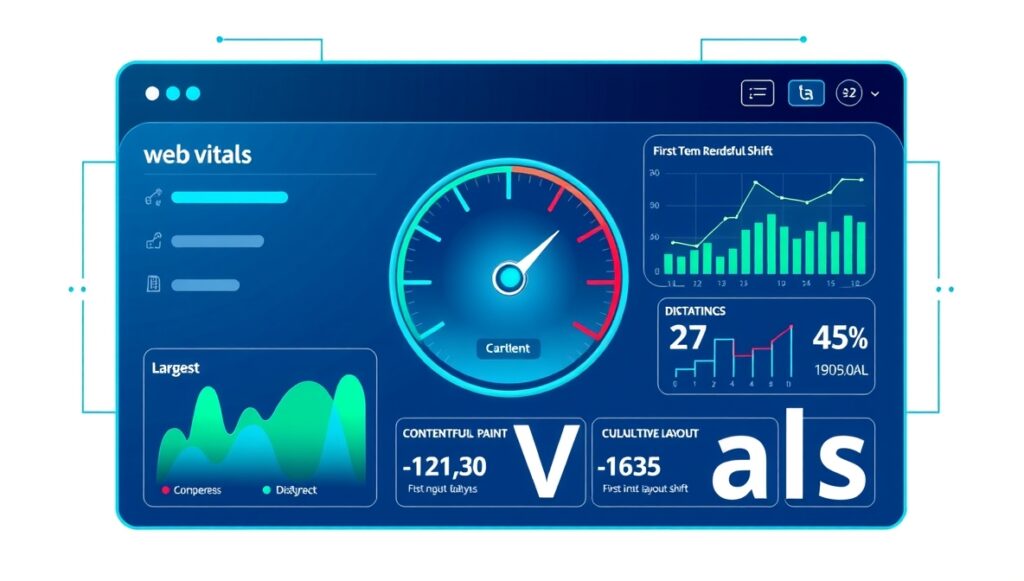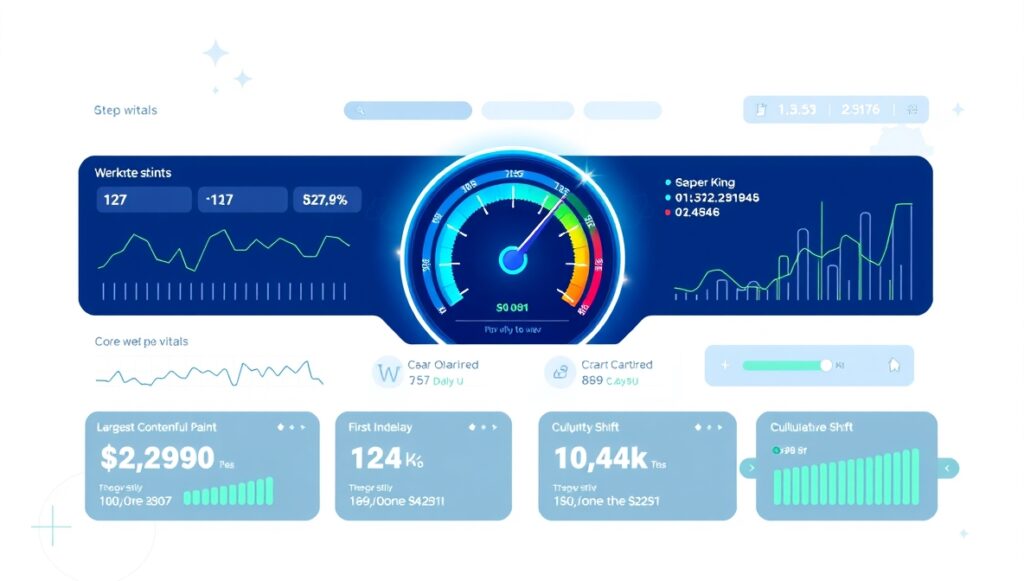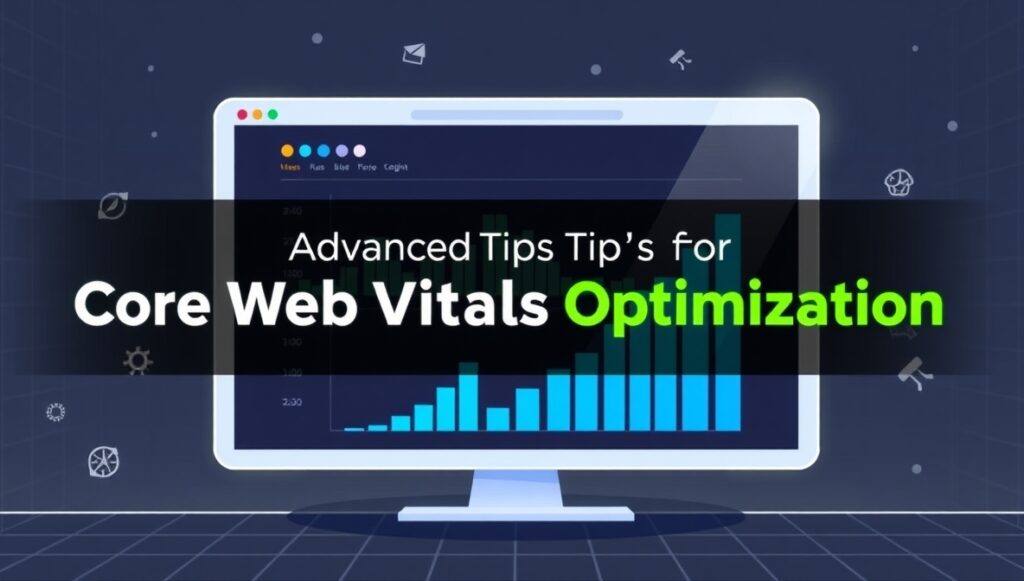Google’s Core Web Vitals are a set of metrics that measure how well your website performs in terms of speed, responsiveness, and visual stability. These metrics are not just technical jargon—they directly impact user experience, search engine rankings, and even your business’s bottom line. If your website loads slowly, feels clunky, or shifts around unexpectedly, users are likely to leave, and Google might push your site lower in search results.
In this article, we’ll break down Core Web Vitals in simple terms, explain why they matter, and provide actionable steps to optimize your website for better performance and SEO. Whether you’re a small business owner, a blogger, or a web developer, this guide will help you improve your site’s user experience and rankings. Let’s dive in!
What Are Core Web Vitals?

Core Web Vitals are three specific metrics that Google uses to evaluate a website’s performance and user experience:
- Largest Contentful Paint (LCP): Measures how long it takes for the main content of a page to load. Think of it as the time it takes for the most important part of your page—like the main image or text—to appear on the screen.
- First Input Delay (FID): Measures how quickly a website responds when a user interacts with it, like clicking a button or a link. It’s all about how “snappy” your site feels.
- Cumulative Layout Shift (CLS): Measures how much a page’s layout shifts unexpectedly as it loads. If elements like buttons or images move around while a user is trying to interact, it can be frustrating.
These metrics are part of Google’s broader page experience signals, which also include mobile-friendliness, HTTPS security, and intrusive interstitials (like annoying pop-ups). Since Google rolled out Core Web Vitals in 2021, they’ve become a key factor in SEO rankings, especially for websites aiming to rank high on search results.
Why Core Web Vitals Matter
Optimizing Core Web Vitals isn’t just about pleasing Google—it’s about creating a better experience for your users. Here’s why they’re important:
- Better User Experience: A fast, responsive, and stable website keeps visitors happy. If your site takes too long to load or shifts unexpectedly, users might leave and never come back.
- Improved SEO Rankings: Google prioritizes websites that offer a great user experience. Poor Core Web Vitals scores can lower your rankings, making it harder for people to find your site.
- Higher Conversion Rates: Faster websites lead to more clicks, sign-ups, and purchases. Studies show that even a one-second delay in load time can reduce conversions by up to 7%.
- Mobile Optimization: With more people browsing on mobile devices, Core Web Vitals ensure your site performs well on smaller screens and slower networks.
Now that you understand what Core Web Vitals are and why they matter, let’s explore how to optimize each metric step by step.
How to Measure Core Web Vitals

Before you can optimize, you need to know how your website is performing. Here are some free tools to measure Core Web Vitals:
- Google PageSpeed Insights: Provides a detailed report on LCP, FID, and CLS for both mobile and desktop versions of your site. It also offers optimization suggestions.
- Google Search Console: Shows Core Web Vitals performance for all pages on your site, based on real user data (called “field data”).
- Lighthouse: A tool built into Google Chrome’s DevTools. It analyzes your site and gives scores for performance, accessibility, and more.
- Web.dev: A Google tool that provides a simple interface to measure Core Web Vitals and get improvement tips.
- Chrome User Experience Report (CrUX): Offers real-world data on how users experience your site.
To get started, enter your website’s URL into PageSpeed Insights or Web.dev. You’ll see scores for LCP, FID, and CLS, along with suggestions for improvement. Aim for the “Good” range for each metric:
- LCP: Under 2.5 seconds.
- FID: Under 100 milliseconds.
- CLS: Under 0.1.
If any metric falls into the “Needs Improvement” or “Poor” range, it’s time to optimize. Let’s break down how to improve each one.
Optimizing Largest Contentful Paint (LCP)

LCP measures how long it takes for the largest content element (like an image, video, or text block) to load. A good LCP score is 2.5 seconds or less. Here’s how to optimize it:
1. Choose a Fast Web Host
Your web host plays a big role in how quickly your site loads. A slow server can delay everything, no matter how optimized your code is. Look for a hosting provider with:
- Fast Server Response Times: Aim for a server response time (Time to First Byte, or TTFB) of under 600 milliseconds.
- Content Delivery Network (CDN): A CDN stores copies of your website on servers around the world, reducing the distance data has to travel to reach users.
- Reliable Uptime: Choose a host with at least 99.9% uptime to ensure your site is always accessible.
Popular hosting providers like SiteGround, WP Engine, or Cloudflare offer fast servers and built-in CDNs.
2. Optimize Images
Images are often the largest content elements on a page, so optimizing them can significantly improve LCP. Try these tips:
- Compress Images: Use tools like TinyPNG or ImageOptim to reduce file sizes without losing quality.
- Use Modern Image Formats: Switch to WebP or AVIF, which offer better compression than JPEG or PNG.
- Lazy Loading: Load images only when they’re about to appear on the screen. Add the
loading="lazy"attribute to your<img>tags. - Set Image Dimensions: Specify width and height attributes in your HTML to prevent layout shifts and help browsers allocate space.
3. Minimize Render-Blocking Resources
Render-blocking resources, like large CSS or JavaScript files, can delay LCP by preventing the main content from loading. To fix this:
- Minify CSS and JavaScript: Remove unnecessary spaces and comments from your code using tools like UglifyJS or CSSNano.
- Defer Non-Critical CSS: Load only the CSS needed for above-the-fold content first. Use tools like CriticalCSS to extract and inline critical styles.
- Asynchronous JavaScript: Add the
asyncordeferattribute to JavaScript files to prevent them from blocking rendering.
4. Enable Browser Caching
Caching stores parts of your website (like images and scripts) on a user’s device so they don’t have to reload every time. Set up caching with:
- Browser Caching: Use HTTP headers like
Cache-Controlto tell browsers how long to store files. - Server-Side Caching: Implement caching plugins like W3 Total Cache (for WordPress) or Varnish for faster server responses.
5. Optimize Fonts
Large font files or poorly loaded fonts can delay LCP. To optimize:
- Use System Fonts: System fonts (like Arial or Times New Roman) load instantly because they’re already on users’ devices.
- Host Fonts Locally: Instead of relying on external services like Google Fonts, host font files on your server.
- Use Font-Display: Swap: Add
font-display: swapto your CSS to ensure text is visible while fonts load.
By implementing these changes, you can reduce LCP and make your website feel faster to users.
Optimizing First Input Delay (FID)

FID measures how long it takes for your website to respond to a user’s first interaction, like clicking a link or button. A good FID score is under 100 milliseconds. Here’s how to improve it:
1. Reduce JavaScript Execution Time
Heavy JavaScript can slow down your site’s responsiveness. To optimize:
- Minify JavaScript: Use tools like Terser to reduce JavaScript file sizes.
- Remove Unused Code: Analyze your site with tools like Chrome DevTools’ Coverage tab to identify and remove unused JavaScript.
- Use Web Workers: Move non-UI tasks (like data processing) to Web Workers to keep the main thread free for user interactions.
2. Optimize Third-Party Scripts
Third-party scripts, like analytics or ads, can delay FID. To manage them:
- Load Scripts Asynchronously: Use
asyncordeferattributes to prevent scripts from blocking the main thread. - Delay Non-Essential Scripts: Load scripts like chat widgets or social media embeds after the page has fully loaded.
- Audit Third-Party Scripts: Use Lighthouse to identify scripts that slow down your site and consider removing or replacing them.
3. Break Up Long Tasks
Long JavaScript tasks can block the main thread, delaying user interactions. To fix this:
- Split Tasks: Break long-running JavaScript tasks into smaller chunks using techniques like
setTimeoutorrequestIdleCallback. - Use Code Splitting: Load only the JavaScript needed for the current page and lazy-load the rest.
By reducing JavaScript-related delays, your website will feel more responsive to users.
Optimizing Cumulative Layout Shift (CLS)
CLS measures unexpected layout shifts, like when a button moves just as a user tries to click it. A good CLS score is under 0.1. Here’s how to improve it:
1. Set Image and Video Dimensions
If images or videos load without predefined dimensions, they can push content around. To prevent this:
- Add Width and Height Attributes: Include
widthandheightin your<img>and<video>tags. - Use Aspect Ratio: For responsive designs, use CSS properties like
aspect-ratioto maintain consistent dimensions.
2. Reserve Space for Ads and Embeds
Ads, iframes, or embeds (like YouTube videos) can cause layout shifts if they load dynamically. To fix this:
- Set Placeholder Dimensions: Reserve space for ads or embeds with fixed-height containers.
- Use CSS to Control Layout: Avoid dynamically injecting content that changes the layout after the page loads.
3. Avoid Animations That Cause Shifts
CSS animations or transitions can trigger layout shifts. To minimize this:
- Use Transform Instead of Top/Left: Animations using
transformdon’t affect the layout of other elements. - Test Animations: Preview animations in different screen sizes to ensure they don’t cause unexpected shifts.
4. Optimize Font Loading
Fonts that load late can cause text to shift (a phenomenon called FOIT, or Flash of Invisible Text). To prevent this:
- Preload Fonts: Use
<link rel="preload">to prioritize font loading. - Use Font-Display: Swap: Ensure text remains visible while fonts load.
By stabilizing your website’s layout, you’ll create a smoother, less frustrating experience for users.
Advanced Tips for Core Web Vitals Optimization

Once you’ve tackled the basics, here are some advanced strategies to further improve your Core Web Vitals:
1. Use a Content Delivery Network (CDN)
A CDN reduces latency by serving your website from servers closer to the user. Popular CDNs like Cloudflare, Akamai, or Amazon CloudFront can improve LCP and overall performance.
2. Implement Server-Side Rendering (SSR) or Static Site Generation (SSG)
For dynamic websites, SSR or SSG can reduce LCP by delivering pre-rendered HTML to the browser. Frameworks like Next.js or Gatsby make this easier.
3. Optimize Database Queries
If your website relies on a database (like WordPress with MySQL), slow queries can delay LCP. Optimize by:
- Indexing Database Tables: Add indexes to frequently queried fields.
- Caching Queries: Use tools like Redis or Memcached to store query results.
4. Monitor Real User Data
Tools like Google Search Console and CrUX provide real-world data on how users experience your site. Regularly check these reports to spot issues and track improvements.
5. Test on Real Devices
Simulated tests (like Lighthouse) are helpful, but real-world conditions vary. Test your site on different devices, browsers, and network speeds to ensure consistent performance.
Common Mistakes to Avoid
When optimizing Core Web Vitals, watch out for these pitfalls:
- Ignoring Mobile Performance: Most users browse on mobile, so prioritize mobile optimization.
- Overloading with Plugins: Too many plugins (especially on WordPress) can slow down your site. Audit and remove unnecessary ones.
- Neglecting Real User Data: Lab data (from tools like Lighthouse) is useful, but real user data from Search Console is more accurate.
- Focusing Only on One Metric: Optimize LCP, FID, and CLS together for the best results.
Tools and Plugins to Help
Here are some tools and plugins to simplify Core Web Vitals optimization:
- WordPress Plugins:
- WP Rocket: Adds caching, minification, and lazy loading.
- Smush: Compresses and optimizes images.
- Autoptimize: Minifies CSS, JavaScript, and HTML.
- Performance Tools:
- GTmetrix: Combines PageSpeed Insights and other metrics for a comprehensive report.
- Pingdom: Tests website speed from multiple locations.
- Image Optimization:
- ShortPixel: Compresses images and converts them to WebP.
- Cloudinary: Manages and optimizes images in the cloud.
- Code Optimization:
- Webpack: Bundles and optimizes JavaScript and CSS.
- PurgeCSS: Removes unused CSS.
The SEO Benefits of Optimizing Core Web Vitals
Optimizing Core Web Vitals doesn’t just improve user experience—it boosts your SEO in several ways:
- Higher Rankings: Google rewards sites with good Core Web Vitals scores, especially for competitive keywords.
- Lower Bounce Rates: Faster, stable websites keep users engaged longer, signaling to Google that your content is valuable.
- Better Mobile Performance: With mobile-first indexing, a fast mobile experience is critical for SEO.
- Increased Crawl Efficiency: Faster sites are easier for Google’s bots to crawl, improving indexation.
How to Maintain Good Core Web Vitals
Optimization isn’t a one-time task. To keep your Core Web Vitals in the “Good” range:
- Monitor Regularly: Use Google Search Console and PageSpeed Insights to track performance over time.
- Update Content and Code: Remove outdated plugins, scripts, or large media files that slow down your site.
- Test After Changes: Every time you add new content or features, test your Core Web Vitals to ensure they haven’t degraded.
- Stay Informed: Google occasionally updates its algorithms, so keep up with SEO and performance best practices.
Conclusion
Optimizing your website’s Core Web Vitals is one of the most effective ways to improve user experience, boost SEO rankings, and drive more conversions. By focusing on Largest Contentful Paint (LCP), First Input Delay (FID), and Cumulative Layout Shift (CLS), you can create a faster, more responsive, and stable website that keeps users coming back.
Start by measuring your current performance with tools like PageSpeed Insights or Google Search Console. Then, implement the optimization strategies outlined in this guide—such as choosing a fast host, compressing images, minimizing JavaScript, and stabilizing your layout. Avoid common mistakes, use the right tools, and monitor your site regularly to maintain great performance.

